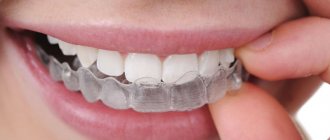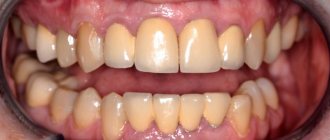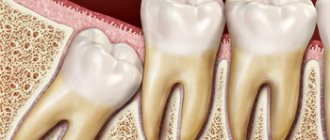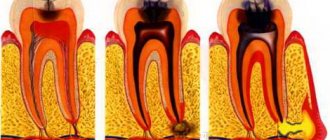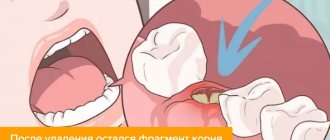What should you do if a small piece of your front, upper, lower or back tooth breaks off? Is it worth resorting to extraction (completely removing the crown) and then installing a prosthesis? Why do strong, hard tissues crack and make your smile unattractive and chewing food painful? In fact, the problem is quite common and can be eliminated in a short time if you consult a dentist in time and do not neglect treatment. In addition, there are preventive measures that, if followed, will help avoid the formation of cracks and chipping.
Reasons for chipping
What causes pieces of teeth to break off (what to do next depends on the provoking factors) most often:
- Traumatic effects on the dentition. This is possible due to a fight, a fall, or an accidental blow.
- Decreased immunity.
- Poor quality installation of orthodontic structures.
- Hormone imbalance. One of the prerequisites is diabetes mellitus and other endocrine diseases.
- Consumption of harmful foods. Caramel candies, nuts, and the simultaneous consumption of hot and cold foods lead to injury.
- Untreated dental pathologies.
- Incorrect positioning of incisors, canines and molars and nocturnal bruxism.
- Damage to caries. This applies to both the initial and later stages.
- Smoking and other bad habits. Alcohol and cigarettes contribute to the thinning of the enamel layer.
- Demineralization, lack of phosphorus, calcium and other essential substances.
- Low acidity in the mouth. An insufficiently balanced diet leads to an imbalance in the acid-base balance.
- Damage to the filling material.
- Presence of cracks on the surface.
- History of chronic diseases.
Causes
The question of why teeth chip off worries many, especially when it comes to children’s teeth. Not only does this bring some aesthetic discomfort; but often the surrounding tissues are also injured, and this can be much more dangerous. There are several most common reasons why a person’s tooth may break off:
- As a result of injury;
- Anomaly or pathology;
- Lack of useful elements, such as calcium;
- Hormone imbalance;
- Reduced immunity.
In addition, according to some scientists, teeth can chip due to the fact that the acidity in the mouth is reduced. Often the tips of the incisor also break off when trying to bite through something hard.
Symptoms
Treatment of a small chip on the enamel of a tooth (front or back) should be started as early as possible. If the broken fragment is too small, it may not cause any discomfort, only aesthetic. This does not mean that you should neglect a visit to the doctor, since very soon the problem will grow to much more serious proportions, and therapy will be long and expensive.
Characteristic symptoms:
- visible cracks on the surface;
- loss of filling;
- exposed nerve endings;
- violation of the integrity of the coronal part;
- increased sensitivity to temperature changes;
- pain syndrome, especially at night.
What to do if your front tooth is severely chipped?
Small chips of the front tooth can be restored on the day of visiting the dentist, however, severe damage involving the pulp requires its removal and treatment of the chipped front tooth. After therapy, canal filling and crown installation are prescribed. In severe cases, tooth extraction is performed and prosthetics are prescribed.
Deputy Chief physician Sergey Evgenievich Brodsky
Sign up for a free consultation
+7
Types of damage
There are several types of dental injuries with fractures. The classification sign is the depth and degree of injury.
Enamel chip or microcrack
In this case, the integrity of the upper layer of hard tissue is compromised - it cracks, or a small fragment separates. Usually such problems are invisible and do not cause discomfort. These are minor defects that can be quickly treated, but people do not rush to the dentist with them, which is a serious mistake.
What to do if part of a front tooth or a piece of a back tooth chips or falls out? It is important to visit a dental clinic as soon as possible. Damaged structures will become a place for the spread of pathogenic microflora, which will provoke the development of caries and other diseases. In addition, the load when chewing food will increase significantly, so half of the crown may fall off at any moment.
Chip with dentin fracture
Dentists classify this type of damage as moderate. Symptoms may be pronounced or completely absent. If the dentin layer is not restored, the unit will gradually crumble and soon fall apart. In addition, the smile will become unattractive, especially if a piece of an incisor is missing.
Deep fracture to the pulp tissue with exposure of the nerve
This is a severe injury with serious symptoms such as bleeding and severe pain. Even strong painkillers help dull unbearable sensations only for a short time. The crown may be missing half or more. If you are late with medical intervention, the risk of infection, inflammation and other pathological processes that are difficult to treat increases significantly.
Tooth fracture - symptoms and treatment
Transverse (horizontal) fracture
In case of a fracture of the crown part of the tooth without damage to the pulp, caries may develop in the absence of treatment and subsequently pulpitis and periodontitis. In case of a fracture accompanied by exposure of the pulp, acute pulpitis is a complication. The occurrence of pulpitis is accompanied by pronounced pain in the area of the causative tooth with irradiation (spread) along the branch of the trigeminal nerve to the area of neighboring teeth or antagonist teeth. The pain mainly occurs at night. Without appropriate treatment, acute pulpitis can turn into chronic pulpitis, and later into periodontitis, characterized by the symptom of an “overgrown tooth” (the feeling that a tooth has come out; you cannot bite on it, as it causes pain). You can clearly identify the causative tooth by performing percussion - tapping on the tooth. Pain also occurs when eating hot food.
In the absence of treatment, after some time the process of pulp sclerosis begins - degeneration, pulp atrophy, its replacement with connective tissue. As a rule, there is no acute pain at this stage, but chronic inflammatory processes - osteitis or radicular cysts - begin to develop in the bone surrounding the tooth.
Vertical tooth fracture
This injury is incompatible with the continued existence of this tooth in the alveolus. Without treatment (in this case it involves tooth extraction), the situation leads to the rapid development of an inflammatory local process - dental periodontitis, which can later develop into periostitis (inflammation of the periosteum), osteomyelitis (chronic inflammation of the bone, which leads to resorption of bone tissue in the area of the lesion). ) and into extensive inflammation of soft tissues - an abscess of the maxillofacial area.
In this case, a purulent infiltrate appears around the tooth, melting the surrounding tissue. The patient's general condition worsens, the temperature rises, and swelling of the buccal or submandibular area occurs. Without appropriate treatment (tooth extraction, opening of periostitis or abscess), the process quickly becomes diffuse. In this case, phlegmon of the soft tissues of the face and neck may occur. Such a rapid and dangerous course of inflammatory processes in the oral cavity is due to the structural features of the cellular spaces of the face and neck. Cellular spaces are located between the muscle fascia. They are loose connective tissue. A distinctive feature of this tissue is the rapid development of purulent inflammation in it, which then spreads to nearby muscles and tendons.
Complications of a fracture also include resorption (external and internal) of the tooth root after injury. It appears after a few months. Resorption can be in the area of the apex (apex) of the root or in the area of the tooth root fracture. It occurs due to the lack of a “replacement callus”, which should restore the tissues of the tooth root - dentin and cement. The symptoms are quite sparse. This may be tooth mobility or pain when biting on a tooth. As a rule, it is possible to clearly diagnose resorption after an X-ray examination. This situation is a late complication of a tooth fracture. The tooth must be removed [9].
What to do if a piece of a tooth breaks off
First of all, you need to visit a dentist. Panic is unacceptable, since the situation is fixable, and at the initial stage it is quickly corrected. A specialist should examine the oral cavity and assess the extent of the problem. If the damage is mild or moderate, it is advisable to carry out treatment in the coming days. If the pulp is exposed, you need to urgently go to the doctor on duty. Otherwise, the patient will not be able to eat, rest, or sleep normally due to unbearable pain.
Relieving symptoms at home
To reduce discomfort and relieve pain, it is necessary to organize pre-medical care. The remaining manipulations will be performed by professional doctors after a visit to the dental clinic. Procedure:
- Rinse your mouth with clean running water.
- To reduce swelling, apply a cold compress to the inflamed area. Apply a sterile bandage if bleeding occurs.
- Take painkillers.
If a piece of a tooth breaks off, the nerve hurts, or the root is split, you should not throw away the fragment of tissue; it is better to show it to a doctor. The fragment may be needed for subsequent restoration.
Emergency assistance before visiting the dentist
Immediately after the incident, urgent measures must be taken. All the steps listed above are mandatory: first, splinters and particles of food are removed by rinsing, then cold is applied to the gums to eliminate inflammation and discomfort, and oral analgesics are used.
Additionally, it is recommended to rinse the mouth with a weak antiseptic solution. To do this, you can use chlorhexidine, furatsilin or any other gentle composition.
Treatment by a doctor
There are several ways to repair a chipped tooth (how it is treated depends on the degree of damage and the presence of pain). Therapeutic intervention options:
- Artistic restoration. Special composites are used. Acceptable when breaking off small fragments.
- Installation of veneers and lumineers. Used for cracks, chips and formation of crevices.
- Recover using tabs. This is how a significant piece of bone tissue is reproduced.
- Prosthetics (crowns). Indicated when most of the dental unit is missing.
Restoring a chipped tooth
If chips appear, the dentist will suggest the patient to restore the chipped tooth using one of the following methods:
- Building up a chipped tooth using filling materials (direct restoration). It is performed using modern composite light-curing polymers directly in the dental chair.
- Installation of veneers or crowns (indirect restoration). It is performed using microprosthetic structures made from individual impressions in a dental laboratory.
- Installing a tab. In case of severe destruction of the crown of the tooth, when the chip is too large and it is necessary to create a solid foundation for future prosthetics, restoration of the crown is carried out using an inlay - in some cases it can act as an independent filling, in some it serves as the basis for installing a crown.
Restorative methods in dentistry
The method of restoration depends simultaneously on several factors: the degree of damage, the results of diagnostic studies, general health, medical history and financial capabilities of the patient. The therapeutic regimen is developed on an individual basis. What to do if a front tooth is chipped and why the back teeth are chipped should only be determined by a doctor; self-diagnosis is ineffective.
Remineralization
Remineralization therapy is the simplest recovery option for minor chips. The technique is used for microcracks and other small defects, as well as for preventive purposes to prevent such problems. A special solution with nutrients is applied to the surface, and as a result, the protective properties of the enamel are restored.
Fluoridation
Damaged and healthy teeth are covered with medicinal solutions, gels or varnishes with a large amount of fluoride. Treatment is carried out in stages. This is one of the effective ways to completely restore a chipped front tooth. This method is only beneficial for minor injuries.
Building up
Indicated for moderate injuries. A paste-like mass is applied to the surface in layers, each layer is fixed. The doctor must carefully select materials of the desired shade and texture so that the restored areas remain invisible and do not stand out from the rest.
This method is highly effective and attractively priced. The first thought that arises in most patients when asked what to do if a back tooth is chipped (chipped front teeth are rarely eliminated in this way) is to build up the missing fragment. The technique is in great demand.
Filling and microprosthetics
They are indicated for extensive damage to bone tissue and internal sensitive layers. The doctor carefully examines the results of diagnostic studies (including panoramic and spot images), listens to the patient’s complaints and advises which method is best to use. Restoration is possible using conventional fillings, inlays, veneers, and lumineers. What to do if a back tooth breaks off (the reasons do not matter) and is completely lost? In such a situation, prosthetics using implants or installation of artificial crowns is performed.
The amount that the patient sees in the final settlement after the intervention may be unpleasantly surprising. Before you ignore a small crack in the enamel and neglect a visit to the dentist, it is better to think about possible upcoming expenses.
Cost of restoring a chipped tooth
The cost of restoring a chipped tooth depends on many factors. The Partner-Med clinic has the most reasonable prices in Moscow. Thus, the price of restoring a front tooth using veneers starts from 15,900 rubles, the cost of a crown starts from 7,000 rubles, and filling will cost 2,400 rubles.
The Partner-Med clinic employs only qualified specialists who will help you choose the most optimal method of treating chipped teeth at an affordable price. We can install veneers, crowns, implants made from high-quality materials, and a tooth restored using artistic restoration, if the dentist’s recommendations are followed, will last for decades.
Request a call back or dial our number!
+7
This phone call does not obligate you to anything. Just give us a chance and we will help you!
Just pick up the phone and call us!
+7
We will definitely make you an offer that you cannot refuse!
Special cases
Some injuries require a specific approach, which has its own characteristics against the backdrop of generally established rules. We should look at them in more detail.
Wisdom tooth
"Eights" cannot be restored. The fact is that this makes no sense, because they are not involved in the process of chewing food and are not so important for the functioning of the maxillofacial apparatus. Doctors resort to extraction; subsequent prosthetics are not performed.
Unit
Such damage is the most aesthetically unattractive, because it is visible to others if a person smiles or simply talks. Treatment methods can be any, it all depends on the dentist’s recommendations and the patient’s personal preferences and financial capabilities.
Most often, artistic restoration is used. The specialist selects the composition of the required shade and applies it to the surface. The layer of material is fixed with a special device with light radiation.
What to do if half a tooth breaks off, how will it be treated (a significant fragment has broken off along with dentin)? In this case, veneers are used. This is a reliable method that is durable. Over time, the color of the enamel does not change and remains attractive.
For the most serious damage, crowns made of ceramics, metal-ceramics, and zirconium oxide are installed. The final cost of therapy depends on the choice.
Lateral teeth
They are treated in the same way as the front ones. However, since others cannot see from the outside that there is anything wrong with your smile, ordinary fillings will do. The best option is extension. Overlays are not installed in this case.
If the nerve is damaged, the wound is first treated with an antiseptic. Then depulpation or extraction is carried out followed by prosthetics.
Dairy elements
What to do with a chipped tooth and how to treat it if it hurts? Many parents mistakenly believe that there is no need to correct problems that arise with children’s first incisors, canines and molars - they will fall out sooner or later anyway. This is a big misconception, because the doctor is able to quickly stop further cracking with a filling or a special gel without pain or other unpleasant sensations.
Children are often injured due to falls during active play. If you ignore the treatment of chips, this often leads to stomatitis and increased sensitivity of the dentition.
Procedure:
- calm the baby;
- give him clean water to rinse his mouth;
- disinfect soft tissues if they are damaged;
- save the fragment for the dentist.
No more than 24 hours should pass from the moment of injury to the visit to the dentist. Most likely, the child will be sent for an X-ray. The condition of the permanent one depends on the health of the primary occlusion.
Vertical crack
What should you do if your front tooth chips a little, but the absence of fragments is not visible, only a crack running from top to bottom is noticeable? At first glance, this problem seems insignificant. However, this opinion is erroneous, because most often the pulp is involved. In this case, the enamel layer cannot be restored.
If at first only a small strip is visible on the surface, over time, under constant pressure, it develops into large chips. Timely consultation with a doctor guarantees quick and easy restoration of the dental unit. Otherwise, you cannot do without installing crowns or veneers.
Should I save the piece that fell off?
If part of a tooth breaks off , if possible, you need to find it and take it with you to the appointment. If necessary, the doctor, using modern materials, can glue it back. By fixing a broken fragment, a tooth today can be restored not only to its natural appearance, but also to full functionality. This cannot always be achieved by creating an imitation, albeit an accurate one.
What if a baby tooth breaks off?
The fragment needs to be washed, put in milk, or, in extreme cases, just in water, and immediately go with the child to the clinic. You shouldn’t think that baby teeth will soon be replaced by permanent ones, so you can leave everything as is. If the child does not even complain of pain, an infection can penetrate into the exposed dentin. Sooner or later, inflammation will reach the pulp, and then the periodontium. This will cause a whole chain of further troubles.
In addition, the rudiments of permanent teeth form under the milk teeth, which can also be affected by injury. If the pediatric dentist determines that there is a direct threat to the bud, the baby tooth will most likely be removed.
Complications after chipping
Restoring a chipped front tooth or a chipped molar (what to do in the case of different types of damage is discussed above) should be mandatory. Firstly, the aesthetic component suffers. A smile looks ugly, a person develops complexes, he is always afraid that others will notice the defect. Secondly, if you neglect medical intervention, you cannot avoid negative consequences (sometimes irreversible). These are problems such as:
- malocclusion;
- curvature of roots;
- increased sensitivity to external stimuli (cold, hot, sour, sweet);
- pulpitis, periodontitis and other diseases.
All of these conditions are considered very serious. Most of them often lead to the loss of units and affect the health of neighboring elements.
Oral diseases affect other organs. For example, if a large piece of a back tooth breaks off and the remaining fragment or the entire row hurts, this can later be associated with diseases of the gastrointestinal tract, heart and blood vessels, and urinary system. Even microcracks can lead to such complications. Thus, unpleasant consequences can only be avoided with the help of timely intervention by a dentist.
What to do if a tooth is chipped?
If the enamel or crown of a tooth is damaged, you should consult a dentist, who will determine the need for treatment and the possibility of restoring the chipped tooth. Before contacting the clinic, it is necessary to prevent the occurrence of infectious processes and the further spread of a chipped tooth below the gum level. For this purpose, dentists at the Partner-Med clinic recommend:
- rinse your mouth with water with added salt and soda or chamomile decoction to remove debris;
- irrigate the oral cavity with a solution of Chlorhexidine or Miramistin;
- apply a cold application to the gum;
- take a pain reliever (Analgin, Ketanov, Ibuprofen) or apply a compress of gauze soaked in Lidocaine or Novocaine to eliminate pain;
- eat only soft and warm foods.
If a large piece has broken off as a result of damage, it must be found, since often with its help and composite materials it is possible to restore a chipped tooth.
Prevention
To prevent chipping of hard tissues, you must adhere to the following rules:
- do not neglect daily cleaning and other hygiene procedures;
- visit the dental clinic every six months for preventive examinations;
- promptly treat caries and other diseases;
- adhere to a proper balanced diet;
- lead a healthy lifestyle, eliminate bad habits;
- if the bite is broken, take measures to correct it;
- minimize the risks of traumatic effects (too hard food is one of the main reasons why a piece of a back tooth breaks off, an incisor or a fang breaks off);
- periodically resort to professional cleaning to remove plaque and stone;
- consult a doctor even if microcracks appear that are not accompanied by unpleasant symptoms.
The dentition is a vulnerable place, especially if you neglect hygiene rules, often chew caramel, smoke, ignore oral diseases and make other mistakes. Chips of the enamel and deeper tissues often lead to serious complications if restoration is not started in time. Before determining what to do if a piece falls off or half of a tooth breaks off, the doctor must determine the extent of the damage and decide whether it is possible to restore the dental unit without resorting to the last resort - extraction.



